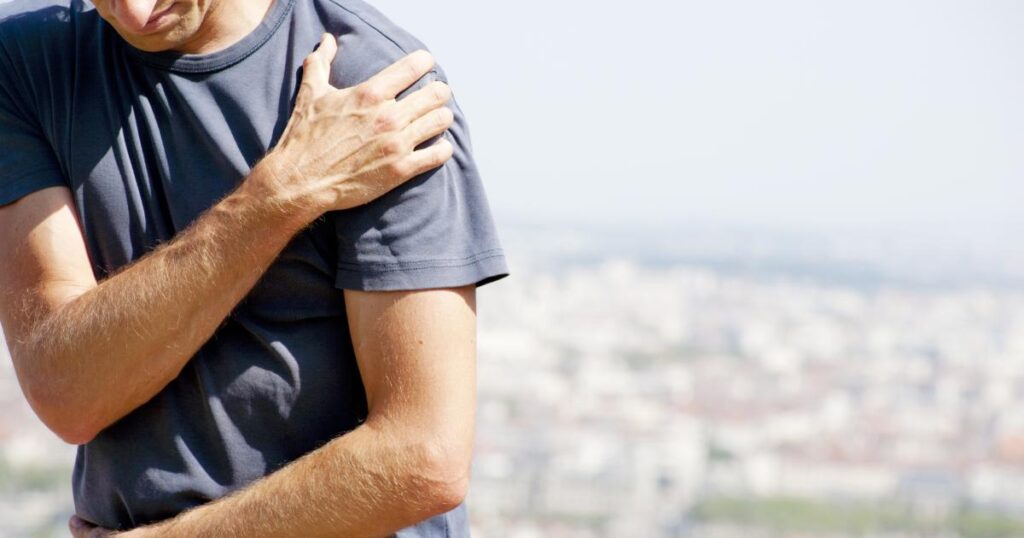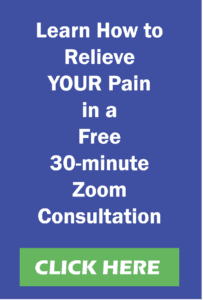
In the last few weeks, shoulder injuries have seemed very common. Most have been simple range of motion issues while a few have been more extreme like a torn muscle. Many people suffer daily with shoulder stiffness believing it is an age thing, when in fact, it is a movement thing. Today, I want to talk about why shoulders become stiff and painful, what typical treatments are tried, and what you can do to resolve most of the aches and pains you feel from time to time.
How the Shoulder Works, and Why it Hurts
The shoulder is a very complicated joint when looking at the mechanics of the muscles that make the shoulder move in each direction. The joint itself is fragile from the bone perspective. The upper arm bone, the humerus, attaches to the socket on the shoulder blade, which is held up by the collarbone only. This means if the collarbone breaks, the arm drops down as there is little to hold on to it. That is the simple but fragile part of the shoulder.
The muscle aspect is a very different view. Basic shoulder movements we do daily may seem basic, but it takes many muscles just to make those simple moves happen. For example, lifting your arm over your head requires:
Follow these steps
1) The outside chest muscle, the Pec minor, releases and elongates.
2) At the same time the shoulder blade must rotate to raise the arm and this requires the muscles between the shoulder and spine to release and the muscles on top of the shoulder to release at the same time.
3) Finally, the muscles on top of the shoulder, the traps and supraspinatus, then contract to lift the arm. All of this must happen simultaneously but if one of these muscles spasms you can have minor pain to massive pain in the neck, shoulder, and back.
How Can the Shoulders Create Pain?
Neck pain can be due to the muscles on top of the shoulder overworking because the muscles in the chest or back are not working properly. This can lead to headaches on the side and back of head, neck pain, and pain on top of the shoulder itself. You can beat the neck to death, but until you release the muscles that are forcing the neck and upper shoulder muscles to overwork, relief can only be temporary.
Back of shoulder pain to mid-back pain can be caused by the outside chest muscle, the pec minor. Most activities in our lives require us to lean forward which means we round our shoulders by shortening the outside of the chest. Over time, this can cause the muscles on the back of the shoulders and mid-back to overwork leading to pain. Doing exercises like push-ups, chest press, and butterflies can create the same pain. Ironically, driving your car and working on a computer will accomplish the same result.
There is an additional issue when the outside of the chest is tight. You can develop head-forward posture. To see what I am talking about, stand sideways in front of a mirror, allow your shoulders to round forward and watch how much your head automatically leans forward. Over time, the muscles on the front of your neck, the sternocleidomastoids, will shorten and create neck pain on the back of your neck. The head needs to be balanced on top of the shoulders to reduce the compression down the spine. Every inch your head leans forward increases the amount of pressure at the base of your neck by 10 pounds.
Most people tend to lean forward from the common activities they do, from driving, computer work, exercise, and even walking. Sadly, if the shoulders remain in this forward leaning position, the risk of rotator cuff injuries increases, or joint damage can occur.
Typical Treatments for Shoulders
Wearing a back brace: There are braces designed to force the shoulders back hoping to improve the posture. Looks like a great idea at first, however, if the chest muscles aren’t released, once the brace comes off, the shoulders will just round again. Though it is forcing the chest to open, the brain does not believe it. For some, while wearing the brace, relief happens while for others it is a fight and becomes too much pressure on the shoulders.
Strength Training for the Back: Many times, we are told to do Seated Lat Rows or bent over rows with dumb-bells to improve the strength of the mid-back with the thought if we have enough strength, we can pull the chest open. Again, it looks like it should work, however the back muscles will fatigue out when trying to hold the chest open all day. Think of trying to hold a weight straight in front of you for an hour. Regardless of the weight, the arm will get tired and so will your back.
Injections: This will stop the pain by shutting off the receptors to the brain that say your shoulder hurts. It will also increase the risk of injury because if you think your shoulder is fine, you may overdo an activity and damage the shoulder joint or muscles.
As you can see, these treatments are temporary at best and may do more damage in the long run. It is best to understand what is causing the pain, before attempting to correct the problem.
How Can You Solve a Shoulder Issue?
First, we need to know what is causing the pain. Stand in a doorway with your arm of the painful shoulder lying up along the door frame. Slowly step through the doorway. If you feel tightness along the outside of the chest, it is most likely the outside chest muscle. The outside chest muscle can show up as pain on the back side of the shoulder, side of the neck, and mid-back.
Second, stand sideways in front of a mirror and notice if your head is leaning forward. If it is, then the muscles on the front of your neck are short and this can lead to pain at the base of your head or in the mid-back.
Remember, when it comes to muscles, wherever the pain is, the cause is usually the opposite side or opposite end from the pain. There are several stretches you can do to help improve your posture and reduce the pain in your shoulders. I will post a couple down below.
A simple thing to do each day, several times a day, is place your chin in the palms of both hands. Take a moment and feel the weight of your head on your hands. Without using your neck muscles, lift your head with your hands and look up to the ceiling. Hold for 5 seconds and repeat 10 times. The repetition will show your brain this is safe.
Stretch the outside chest muscles each day. Stand in a doorway, place one hand behind your head and place the elbow of the same arm against the door frame. Gently use your feet to rotate your body away from your elbow. In other words, if you are using your right elbow against the door frame, turn left. Hold for 5 seconds and repeat 10 times.
A second stretch for the outside chest muscles is, place one arm against a door frame as you stand next to it. Extend your arm towards the top of the door. Slowly step through the door with the foot on the same side as your arm. For example, if my right arm is on the frame, I will step through with my right foot. Hold for 5 seconds and repeat 10 times.
You can do any of these, or all of these, any time you want and as much as you want for relief. I would suggest doing them each morning and evening at the least. If pain continues, please see your doctor to see if there is more going on than you think. Releasing the tension in the muscles is a daily thing. Think of a dog or cat and how they stretch every day, several times a day. We should do the same.
In using my Stretch n’ Release Technique, you are allowing the brain to release the muscles versus brute force that you see in many gyms and physical therapy. It takes practice, but once you get it, and you will, your body will feel more energized and vibrant.
Stretching is more about feeling the muscles letting go than forcing them to stretch. If you are forcing the muscle, you could be doing strength training, not stretching. Make sure you are feeling the intended muscle stretching. If not, the form could be wrong. Holding for 5 seconds allows the brain to release the muscle before it senses any danger. Repeating the stretches 10 times allows the brain to learn it is safe for the muscle to move that way.
About The Muscle Repair Shop
Drawing upon his personal experience as a former competitive athlete turned wheelchair, obese, and chronic pain sufferer, Muscle Repair Shop Founder Butch Phelps decided to take his health into his own hands when at the age of 36 he was told he might not make it to his 40th birthday. Applying balanced nutrition advice from his doctor along with a sound exercise program, he went from 315 lbs. to 180 lbs. Motivated by his experience, he then acquired degrees in advanced therapeutic massage and aging sciences to help people eliminate chronic pain. This included applying his expertise in how people age, including the effects of dementia, anatomy, psychology, and the day-to-day struggles of living as an older person to his practice and development of The Muscle Repair Shop’s one-of-a-kind Stretch n’ Release Technique.
Available through in-office and virtual coaching treatment sessions, this unique combination of stretching and breath work teaches the brain to release the emotional side of muscle tension and pain allowing clients to find lasting relief and healing from stiffness, aches, injuries, and chronic pain. The at-home exercises come with customized instructional videos and virtual or in-office support, allowing clients to enjoy and experience life and sports as they did before limitations slowed or curtailed activities.

